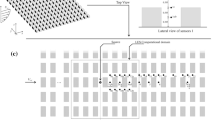Abstract
Experimental studies have shown that tracers injected over short time intervals can often be measured downwind near the ground for a much longer time than would be expected considering the duration of the release and the wind speed. A two-dimensional advection-diffusion model was used in a numerical study to investigate this effect. The results from the numerical study showed that the rate of decrease in concentrations downwind at a receptor after a source has stopped emitting was more sensitive to magnitude of the wind speed and alongwind mixing coefficient than the rate of increase in concentrations when the source first starts emitting. The lower the wind speed or the greater the mixing, the more slowly the concentration decreased as the region upwind of the receptor continued to contribute tracer until it was depleted by advection and vertical diffusion. These atmospheric processes are able, qualitatively, to account for the slowly decreasing air concentrations.
Similar content being viewed by others
References
Draxler, R. R.: 1979, ‘Some Observations of the Along-Wind Dispersion Parameter’, Preprint, 4th Symp. on Turb., Diffusion, and Air Pollution, January 15–18, Reno, NV, American Meteorological Society, Boston, pp. 5–8.
Draxler, R. R.: 1984, ‘Diffusion and Transport Experiments’, Chapter 9, in D. Randerson (ed.), Atmospheric Science and Power Production, DOE/TIC-27601, pp. 367–422.
Draxler, R. R.: 1987, ‘One Year of Tracer Dispersion Measurements over Washington, D.C.’, Atm. Environ. 21, 69–77.
Lott, R. A.: 1984, ‘Performance of a Time-Dependent Dispersion Model in Elevated Terrain’, Atm. Environ. 18, 2367–2376.
Pasquill, F. and Smith, F. B.: 1983, Atmospheric Diffusion, 3rd ed., Ellis Horwood, Chichester, U.K., 347 p.
Sutton, O. G.: 1953, Micrometeorology, McGraw-Hill, Book Co., Inc., New York, 333 p.
Taylor, A. D.: 1982, ‘Puff Growth in an Eckman Layer’, J. Atm. Sci. 39, 837–850.
Weil, J. C.: 1985, ‘Updating Applied Diffusion Models’, J. Climate Appl. Meteorol. 24, 1111–1130.
Author information
Authors and Affiliations
Rights and permissions
About this article
Cite this article
Draxler, R.R. The persistence of pollutants downwind of a point source following termination of the emission. Boundary-Layer Meteorol 42, 43–53 (1988). https://doi.org/10.1007/BF00119874
Accepted:
Issue Date:
DOI: https://doi.org/10.1007/BF00119874




